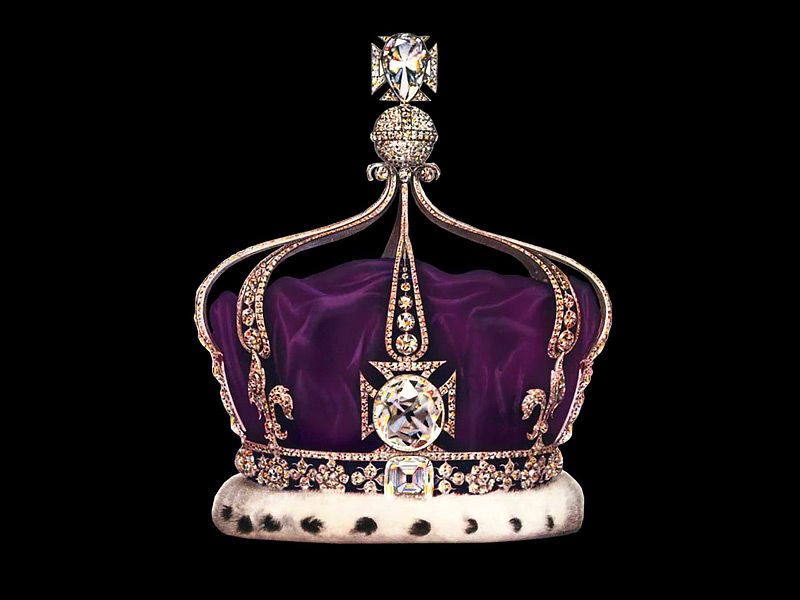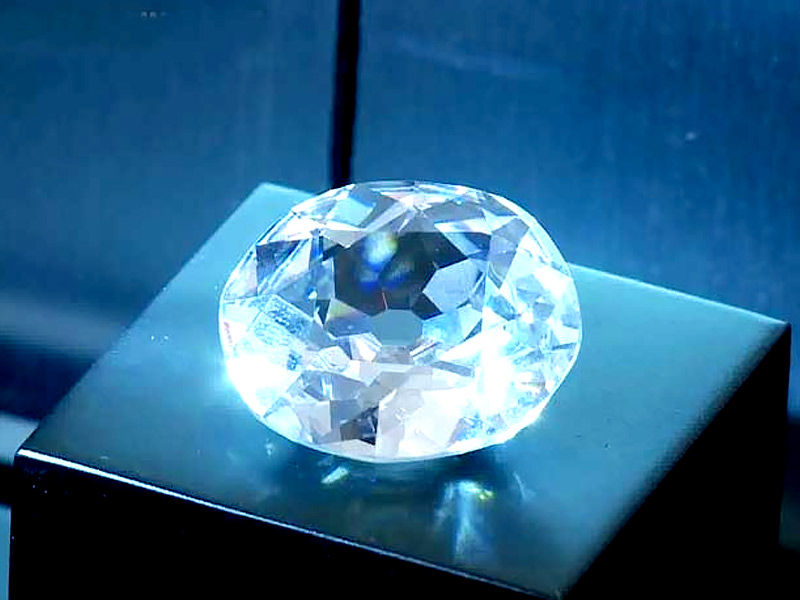Koh-i-Noor, also known as Kohinoor and Koh-i-Nur, is one of the world’s largest cut diamonds, weighing 105.6 carats (21.12 g). It is part of the Jewels of the British Crown.
Possibly mined during the Kakatiya dynasty in Kollur Mine, India, there is no record of its original weight, but 186 old carats are the earliest well-known measurement. Later, it was acquired by Sultan Alauddin Khalji of Delhi. The diamond belonged to the Mughal Peacock Throne as well. It changed hands between different forces in South and West Asia until, after the British annexation of Punjab in 1849, it was ceded to Queen Victoria.

The stone was originally cut in a similar way to the other diamonds of the Mughal period, including the Darya-i-Noor, which are now in the Iranian Crown Jewels. It went on exhibition at the Great Exhibition in London in 1851, but the dull cut struggled to impress the public. Prince Albert, Queen Victoria’s husband, ordered it to be re-cut as a dazzling oval by Coster Diamonds. The culet is exceptionally wide by modern standards, giving a black hole when the stone is viewed head-on. It is although regarded as full of life by gemologists.
The Koh-i-Noor gained notoriety within the British royal family for bringing bad luck to any man who wears it since its history includes a great deal of combat between men. It has been worn since arriving in the United Kingdom only by female family members. It was worn in the form of a brooch and a ring by Victoria. It was placed in Queen Alexandra’s crown, wife of Edward VII after she died in 1901. It was transferred for her coronation as Queen Consort to the Crown of Queen Mary in 1911 and eventually to Queen Elizabeth’s Crown in 1937.

Even today, in the Jewel House at the Tower of London, the diamond is on public display. Millions of visitors per year take a look at it. Since India gained independence from the United Kingdom in 1947, India, Pakistan, Iran, and Afghanistan have all asserted rightful ownership of the Koh-i-Noor and requested its return. The British government reports that the gem was legitimately procured under Lahore’s Last Treaty’s articles and has rejected the contentions.
Also Read, Why was India called the Golden Bird?
The diamond may have been mined from the Kollur Mines, a series of gravel-clay pits 4 meters (13 ft) deep on the Krishna River’s south bank in Golconda, India. It is difficult to know precisely when or where it was discovered. As to its original owner, there are several unverifiable hypotheses.

Babur, the father of the Mughal Empire in Turco-Mongol, wrote about a diamond weighing just over 187 old carats, about the size of the 186-carat Koh-i-Noor. Some historians claim that the earliest credible reference to Koh-i-Noor is Babur’s diamond. It was obtained by Alauddin Khalji, the second ruler of the Khalji dynasty of the Delhi Sultanate. At the commencement of 14th century, he conquered the kingdoms of southern India. He was possibly in control of the Kakatiya dynasty. It later passed to the Sultanate’s successive dynasties. In 1526, Babur received the diamond as a tribute at the Battle of Panipat for his conquest of Delhi and Agra.
The stone was inserted into his ornate Peacock Throne by Shah Jahan, the fifth Mughal emperor. In 1658, the ailing emperor was confined to Agra Fort by his son and successor, Aurangzeb. While in Aurangzeb’s custody, Hortense Borgia, a Venetian lapidary, cut the stone, reducing the broad stone’s weight to 186 carats (37.2 g). Borgia was admonished and fined 10,000 rupees for this carelessness. The tale of Borgia cutting the diamond, according to recent studies, is not accurate and most likely mixed with Orlov, part of the Kremlin’s imperial Russian scepter of Catherine the Great.

The treasury of the Mughal Empire was raided by his army following the 1739 invasion of Delhi by Nadir Shah, the Afsharid Shah of Persia, in an orchestrated and thorough acquisition of the riches of the Mughal aristocracy. The Shah also took away the Koh-i-Noor along with millions of rupees and an array of historic jewels. When he obtained the famous stone, he exclaimed Koh-i-Noor!, Persian and Hindi-Urdu for “Mountain of Light.” One of his associates said, “If a powerful man were to throw four stones into the air, one north, one south, one east, one west, and a fifth stone, and if the gap between them were to be filled with gold, the Koh-i-worth Noor’s would not all be equal.”
The Koh-i-Noor fell to his grandson after Nadir Shah was killed. His empire collapsed in 1747, who, in exchange for his help, gave it to Ahmad Shah Durrani, founder of the Afghan Empire, in 1751. On the occasion of Mountstuart Elphinstone’s 1808 visit to Peshawar, one of Ahmed’s descendants, Shuja Shah Durrani, was wearing a bracelet containing the Koh-i-Noor. A year later, Shuja allied with the UK to help protect Russia from Afghanistan’s potential invasion. He was soon overthrown but fled to Lahore with the diamond. Ranjit Singh, the founding emperor of the Sikh Empire, insisted on the gem being offered to him in exchange for his hospitality.





























